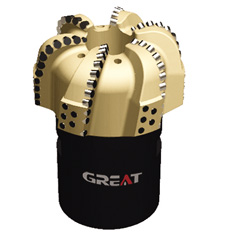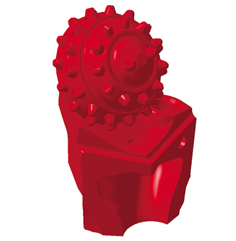The influence of stratum lithology on drill bit failure is reflected in drilling skills: It affects the drilling speed and drilling footage. The drilling process presents complicated situations such as lost circulation, well blowout, well collapse and well stuck. It changes the function of the mud, and it affects the quality of the borehole, such as well deviation and irregular well diameter, which then affects well cementation quality. After analyzing stratum lithology and its influences on drilling skills, the rationality of the drill bit and application can be judged.
1. The influence of clay, mudstone and shale bed: It is very simple to absorb the water in the mud and then swell up, which reduces the diameter of the well and constitutes a resistance of drilling and even stuck drilling. With the extension of the soaking time, the pieces will fall off again, which will expand the diameter of the well and cause a well collapse. So, try to use clean water or mud with low specific gravity and low viscosity for drilling. Carbonaceous shale has a weak connection force and it is easy to collapse. The mudstone layer is soft with a fast drilling speed and it is easy for bit balling.
2. Sandstone: Its properties vary greatly depending on the particle size, composition and cement. The finer the particles, the more quartz particles, the more siliceous and iron cement, the harder it is, the greater the wear on the drill bit, such as quartz sandstone. The more argillaceous cement, the more components of mica and feldspar, the softer and easier to drill. The coarser the particle, the less cementation, the better the permeability, the permeability leakage of mud is easy to occur, and form a thicker mud cake on the wall of the well. It causes complicated situations such as sticking a stuck drill, which causes abnormal use of the drill.
3. Conglomerate: Drilling in the conglomerate layer is easy to occur drill jumping, drill bouncing and collapse of the wall of the well. When the pump displacement is small or the mud viscosity is low, the gravel particles are not easy to go back, which will damage the bit bone and teeth.
4. Limestone: It is usually hard, and it has slow drilling speed and low footage. When drilling into a fractured cavity, it will cause drill bouncing, blowout, mud loss, etc. Sometimes, a well blowout will occur after a lost circulation.
Limestone formation has a great influence on bit footage, rate of penetration, and drill failure. In addition, the stratum is intertwined with soft and hard, such as mudstone and hard sandstone, which are prone to have well deviation. Well deviation tends to occur when the formation dip is large. The drill is easy to be damaged when drilling in an inclined shaft. When the rock layer contains soluble salts, such as gypsum layer, rock salt layer, etc., it will damage the function of the mud and also affect the normal use of the drill bit.
 English
English français
français Deutsch
Deutsch Español
Español italiano
italiano русский
русский português
português العربية
العربية tiếng việt
tiếng việt ไทย
ไทย Nederland
Nederland




